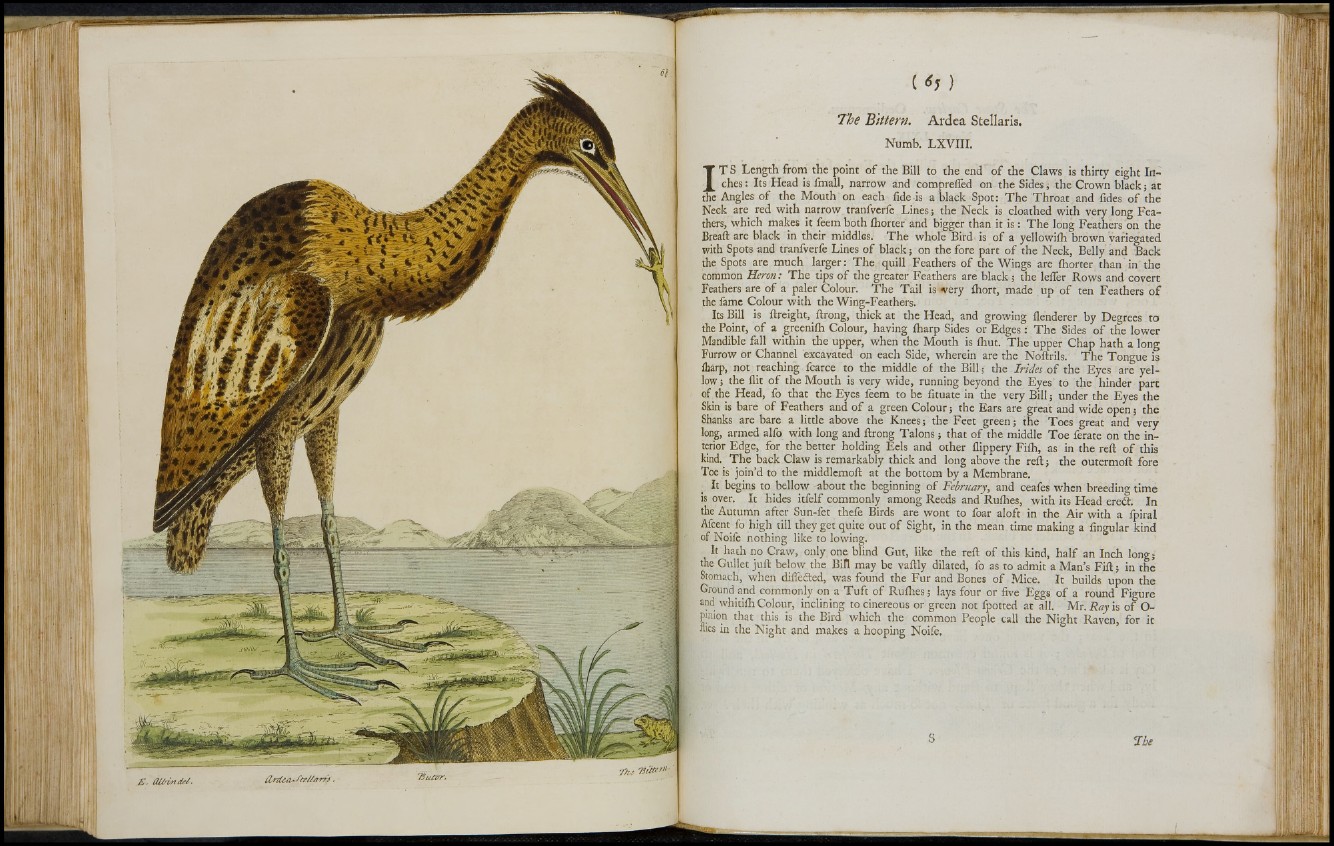
J5. dl/rvndel. fl/rzUa*SttHn,r7? 73u£vr.
The Bittern. Ardea Stellaris.
Numb. LXVIII.
IT S Length from the point of the Bill to the end' of the Claws is thirty eight Inches:
Its Head is finall, narrow and comprefied on the Sides; the Crown black; at
the Angles of the Mouth on each fide-is a black Spot: The Throat , and fides of the
Neck are red with narrow tranfverfe Lines; the Neck is cloathed with very long Feathers,
which makes it feem both ihorter" and bigger than it is : The long Feathers on the
Breaft are black in their middles. The whole Bird is of a yellowifh brown variegated
with Spots and tranfverfe Lines of black; on the fore part of the Neck, Belly' and Back
the Spots are much larger: The quill Feathers of the Wings are Ihorter than in"the
common Heron: The tips o f the greater Feathers are black; the leflfer Rows and covert
Feathers are of a paler Colour. The Tail iswery ihort, made up of ten Feathers of
the fame Colour with the Wing-Feathers.
Its Bill is llreight, ftrong, thick at the Head, and growing flenderer by Degrees to
the Point, of a greeniih Colour, having fharp Sides or Edges: The Sides of the lower
Mandible fall within the upper, when the Mouth is ihut. The upper Chap hath a long
Furrow or Channel excavated on each Side, wherein are the Noftrils. The Tongue is
fliarp, not reaching fcarce to the middle of the Bill; the Irides.of the Eyes are yellow
; the flit o f the Mouth is very wide, running beyond the Eyes' to the hinder part
of the Head, fo that the Eyes feem to be fituate in the very Bill; under the Eyes the
Skin is bare of Feathers and of a green Colour; the Ears are great and wide open; the
Shanks are bare a little above the Knees; the Feet green; the Toes great and very
long, armed alfo with long and ftrong Talons; that of the middle Toe ferate on the interior
Edge, for the better holding Eels and other flippery Fiflh, as in the reft of this
kind. The back Claw is remarkably thick and long above the reft; the outermoft fore
Toe is join’d to the middlemoft at the bottom by a Membrane.
. It begins to bellow about the beginning of February, and ceafes when breeding time
is over. It hides itfelf commonly among Reeds and Ruihes, with its Head eretft. In
the Autumn after Sun-fet thefe Birds are wont to foar aloft in the Air with a fpiral
Afcent fo high till they get quite out of Sight, in the mean time making a Angular kind
of Noife nothing like to lowing.
It hath no Craw, only one blind Gut, like the reft of this kind, half an Inch long;
the Gullet juft below the Bifl may be vaftly dilated, fo as to admit a Man’s F ill; in the
Stomach, when difledted, was found the Fur and Bones of Mice. It builds upon the
Ground and commonly on a Tuft of Ruihes; lays four or five Eggs of a round Figure
and whitiih Colour, inclining to cinereous or green not fpotted at all. Mr. Ray is of O-
pinion that this is the Bird which the common People call the Night Raven, for it
thes in the Night and makes a hooping Noife.
S